For their Good Friday Live from London performance, VOCES8 joined forces with members of the English Chamber Orchestra at Cadogan Hall. Barnaby Smith had moved from his countertenor’s perch to the conductor’s podium, and his place among the vocal octet was taken by soprano Molly Noon – here serving as an alto who could bolster the soprano line as required, and who will shortly be succeeding Eleonore Cockerham as the latter pursues a freelance career from Manchester.
Despite the small changes, so much was business as usual. That characteristic, immaculate VOCES8 blend, and the flawless intonation and ensemble were fully in evidence, and served the music of Fauré and J.S. Bach consummately. And yet, it wasn’t in fact simply ‘business as usual’. There seemed to me to be something different, and fresh, about this performance: more ‘drama’ and a sense of unpredictability; a more individualised sound at times; the communication of intensely human feeling which spoke with personal directness and strength.
Perhaps some of this was a result of the circumstances. The singers were rent from their St Anne and St Agnes home, and the musicians were spread across the large Cadogan Hall stage, the intimacy of their small numbers disrupted by social distancing requirements. There was a real sense of singers and musicians, and conductor, having to put their trust in each other, and it lent this performance a certain immediacy that vitalised the well-honed perfection of a ‘typical’ VOCES8 performance.
I’m going to get my small gripe out of the way at this point. As these Live from London series have confirmed, the VOCES8 ‘machine’ is polished and precise – not just the singing, but the presentation, the supporting materials and the technical expertise are all invested with care, attention and thoroughness. On this occasion, however, while our enjoyment of the performance was enhanced by the well-integrated inclusion of the customary conversations, explanations and ‘extras’, I felt that the engineers took a while to balance the singers and instrumentalists – at first, the sopranos in particular seemed to be disadvantaged, their sheen a little blunted, and the broadcast sound throughout was less than clean.
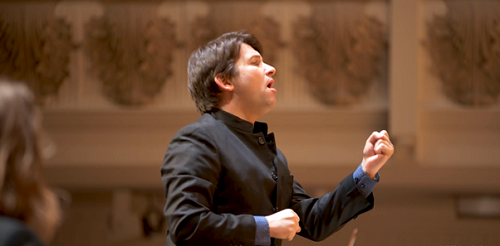
Even this minor irritation couldn’t blunt my enjoyment of this performance, though. From the first, Barnaby Smith drew from the performers both an apt solemnity and a concentrated musical energy which resulted in a sense of spontaneity and propinquity – an ‘in the moment’ intensity, something so hard to create, one imagines, when performing to an empty hall and an unseen audience.
J.S. Bach’s ‘O Jesu Christ, Meins Lebens Licht’ opened the performance and epitomised that union of outer poise and inner currents. This is a work about which many questions remain unanswered. Is it piece a cantata, a motet or a ‘sacred work for special occasions’, as it has been titled? What are the two ‘litui’ indicated in the scoring? What is the original hymn on which it was based? Why are there two versions – one specifying an ensemble composed of two litui, cornetto, and three trombones, and the other calling for two litui, two violins, viola, three oboes, bassoon, and continuo? And, when exactly was it composed? Was it performed in 1740 for the funeral of a Leipzig dignitary?
There were no questions here, though, about the sincerity and spirituality of Bach’s flowing counterpoint. Smith balanced darkness with lyricism. The strong bass line, with its purposeful, regular tread, was countered by bar-crossing tied notes and Smith used this tension to generate a fluidity and organic unfolding. The music seemed to have a strong direction and reached a peak of fulfilment at the close. The solidity of the organ was countered by the singular nasality of the oboe. The ensemble mass was built from discernible layers. Bach’s motet is brief but here it had real stature and swelled with the comfort that Christ’s light brings to the Earth, despite the burden of man’s sins.
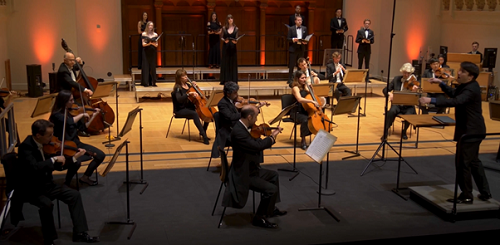
Fauré’s Cantique de Jean Racine was a student prize-winner, dedicated to Franck. The original accompaniment was for organ but Fauré later expanded this in two different versions. We had strings with oboe, horn and harp. Smith generated a good momentum; I’ve heard – and performed – plenty of performances of this work that get stuck in the mud. The tonal palette was gentle and assuring, though at times the vocal sound seemed a little detached, the words muted.
The composer’s Requiem, which followed, was a totally different experience. This is one of those ‘simple’ works which nevertheless has an intense fervour which can be difficult to unlock. If too much emphasis is placed on the devotional restraint, the trajectory from darkness to light is not achieved, or at least not with sufficient exultation. The sombre colours of the scoring of the chamber version can lend an inward quality, but the introspective mysticism needs to be countered by a spiritually driven rise to ascendance.
This performance was both imaginative and entirely persuasive. Though it was intimate, there was a surprising sense of ‘theatre’ – a drama of doubt and faith. Smith was quite daring with his tempi and dynamics. In the Introit, the forceful declaration of the instruments’ accented chords dimmed smoothly into the voices’ pleas for eternal rest, the contrast communicating human pain and need. With the tenors’ first entry, firm but sweet, Smith pushed forwards encouraging purposeful weaving countermelodies from the violas and a strong, regular tread from the cellos and bass. When the sopranos entered with the verse, “Te decet hymnus” (There will be songs of praise to you in Zion), a quiet brightness shone. Emphasising the dynamic contrasts, Smith injected a moving note of anguish into the beseeching cries, “Exaudi orationem meam” (O hear my prayers).
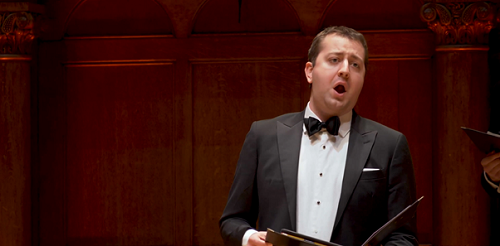
Jonathan Pacey was the baritone soloist in the Offertorium, which once again had flowing momentum, as Smith skilfully controlled the changing colours and texture of the opening, the imitative windings of the strings being answered by the gently blended appeal of the altos and tenors for Christ to deliver the souls of all the faithful departed. The accuracy and oneness of VOCES8’s ensemble sound made such moments effortlessly communicative. Pacey sang with impressive presence, confidently issuing man’s appeal, “Hostias et preces tibi Domine, laudis offerimus” (Lord Jesus Christ, King of glory, we offer unto Thee this sacrifice of prayer and praise). His baritone was relaxed but expressive, the melody lyrical but imbued with drama. (Surely the engineers had flicked a switch here?) The dialogues between solo voice and strings were energising and Pacey made the essential human need for assurance strongly felt.
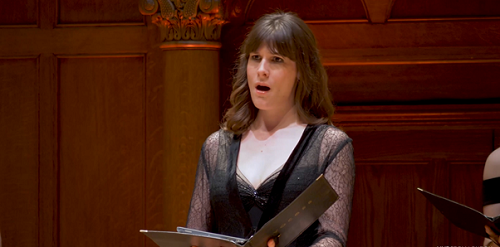
The sopranos gleamed above the oscillating shimmer of the harp and violas at the start of the Sanctus, a truly angelic host, and they were matched for pristineness by leader John Mills’ beautiful violin solo. The celestial reverence was dramatically interrupted by the tenors’ vibrant Hosannas, the music suddenly picking up its feet and marching forward with hope and certainty. Fauré preferred an adult soprano soloist in the Pie Jesu, and Andrea Haines’ exquisite performance suggested that he was right. The slower tempo made the movement stand out as a moment of calm and repose amid the more pressing search for redemption and ultimate peace. Smith simply gave a nod to the organist, James McVinnie, and let Haines get on with it. Her sound had warmth and fullness but also purity and innocence. The line was flawlessly even but never bland, always dignified and human.
With the Agnes Dei, Smith pushed forward once more. The tenors sang with lovely tunefulness, the tone mellow and comforting, drama being added by the horns’ interjections. Smith was ever alert to the potential for dynamic contrasts and I was impressed by the way, as the textures became more airy, he relaxed the tempo a little creating a greater ease and expansiveness, which led naturally into the quiet glow of Christ’s eternal light, “Lux aeterna luceat eis, Domine”.
Pacey was once again an impressive soloist in the Libera Me, singing with a passionate quasi-operatic quality that we seldom hear from him in the context of a ‘typical’ VOCES8 programme. The pulsing accompaniment and vivid vocal line captured the terrible urgency of the Day of Judgement, and the anguish did not lessen with the contrasting whisper of the choral confession, “Tremens factus sum ego et timeo” (I quake with fear and I tremble). The sudden cry, “Dies illa dies irae calamitatis et miseriae” (That day, the day of anger, of calamity, of misery) was almost Verdian in its dramatic impact, and Smith’s deft handling of the juxtapositions and gear changes suggested that he has a good instinct for operatic drama.
The transcendence of the In Paradisum seemed entirely natural after the ups and downs of the journey from darkness, through shadows, to heavenly illumination. The purity of the three sopranos’ floating assurances of eternal rest was deeply calming.
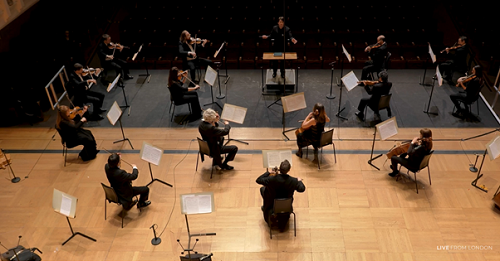
The English Chamber Orchestra had had their own moment in the spotlight earlier in the programme. I wondered how the small forces would fare in Barber’s Adagio for Strings: the original string quartet version has an inherent intensity with just a single voice seeking the music’s emotional extremes, while a full string orchestra can summon a sumptuous sonority that embraces, even overwhelms. I should not have worried. The sixteen musicians played with a classical restraint that brought forth both the fragile delicacy and the inner force of the score. There was a sense of each player listening intently to every other musical line. When the cellos had the main theme, the music gained a fresh energy, as if lifted from below. The ensemble sound remained sweet even at the most intense peaks, and somehow it seemed to have a very ‘human’ quality. After the climax, the cellos’ low murmurs brought quiet relief, and there was a sense of consolation when the voices restarted and the melodic unfolding began again, after the music seemed almost to have burned itself out. This music is known so well, but the ECO made it new, fresh and inspiring.
The concert closed with an arrangement for voices and chamber ensemble of Elgar’s ‘Nimrod’ from the Enigma Variations by Taylor Scott Davis. ‘Nimrod/Lux aeterna’ was dedicated to ‘all those who have been lost, suffered loss, or have been impacted by the global pandemic’.
Claire Seymour
VOCES8, English Chamber Orchestra, Barnaby Smith (conductor)
J.S. Bach – ‘O Jesu Christ, meins Lebens’, Cantata BWV118; Barber – Adagio for Strings Op.11; Fauré – Cantique de Jean Racine Op.11, Requiem Op.48.
Cadogan Hall, London (streamed performance); Friday 2nd April 2021.
ABOVE: VOCES8 and the English Chamber Orchestra at Cadogan Hall